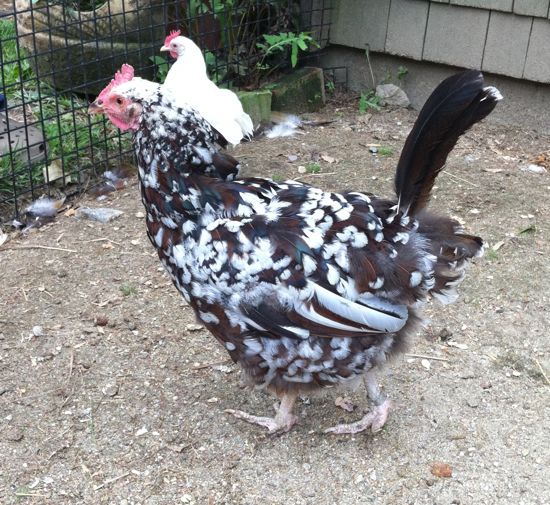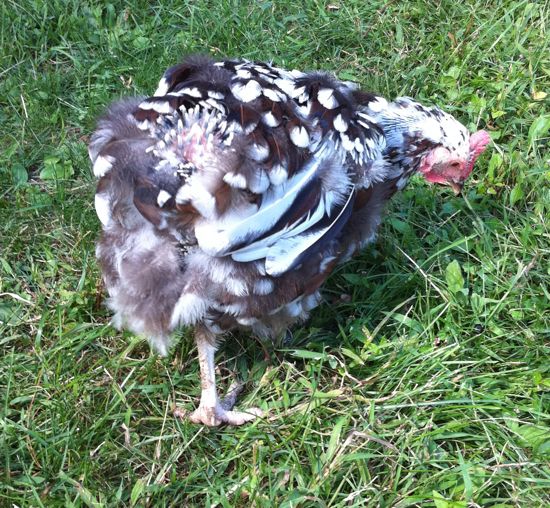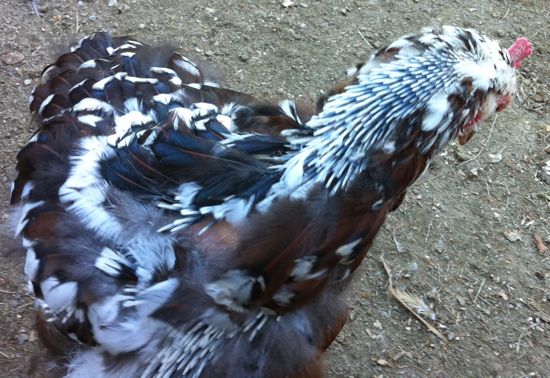This time of year is when the hens molt. They shed their old feathers and grow new, warm coats for the winter. Some hens lose a few feathers and you can hardly tell that they’re molting. Others seem to lose them all at once.
Lulu is our crazy hen. Whatever she does, she does it with a zany energy. Of course, Lulu’s molt is way more dramatic than the other girls’. First she lost her tail. Here she is going by the name of Lulu Two-Feathers. Doesn’t she look like she has on one of those child’s costume Indian headdresses that you used to find at the five and dime store?
A few days later, she looked like a woebegone stuffed animal. Bare and moth-eaten.
Next, Lulu does her best porcupine imitation.
These pinfeathers will unfurl into beautiful black and white feathers. Most of the other hens are molting, too, but none look like this. I love Lulu dearly, but I’m glad there’s just one of her!




Must be a speckled Sussex thing, Bibby is the same, and before the other girls – I always say that she looks like a child playing Indians too! Is Lulu a good layer? (Speckleds are traditionally way behind Lights and Buffs in the Sussex laying stakes) Normally the best layers do the most dramatic moults. Hens that moult in dribs and drabs are usually poor layers, and were often culled as not being considered to be worth keeping through the winter. Good Buff was completely bald in her first moult, after her 250 eggs in that year! Now, at four years old, she only really loses her face and ‘cushion’ feathers, and is down to 100 eggs a year…
I’ve no idea if Lulu is a good layer. She’s too busy being dramatic. She spent most of the summer being broody. Now she’s molting. Which takes her ages. Then, it’ll be winter. We keep her around for the humor of it!
One of my Buff Orpingtons is molting a little, but I’ve noticed she is quiet and withdrawn from the other girls. She’s eating, but just seems “off” and I wonder if molting causes that lethargy. I don’t care if my girls lay all the time, but I want them to be happy!
Yes, they can slow down with the molt. Make sure they’re getting plenty of protein in their diet. That will help the feathers grow back in. Some people add cat kibble, but I don’t like to add meat products to the diet. Access to more worms, or hard cook some eggs and mince and feed to them, are ways to add protein.
I noticed her checking out a bird that had flown in and was inspecting the nesting boxes yesterday. She look very bedraggled. Not having any chickens of my own, (some day!) I wasn’t sure if it was molt or something else. Thank you for clearing that up for me!
It looks like all twelve hens exploded in my hen house.
I am ready to go into the feather pillow business. Just cleaned my coops top to bottom this weekend and lo and behold..looks just like Kathy said…exploding birds!
I have two now that lost every ONE of their wing feathers. I cannot ever recall that. So each night when I go lock up they are waiting for me and clucking softly. Yes they want to be put to bed and I agree to it. I have to set them up on the roost and if they don’t settle down right away they have a tendancy to lose their balance and fall off and we do it again.
interesting thought on the laying/molting idea. I have also heard the redder the comb the better layers they are. Any truth to that?
Yes, a plump, red comb is a sign of a healthy hen. Healthy hens are better layers. Parasites and disease will make the comb pale, or turn bluish. OTOH, a good layer’s yellow legs will go pale!